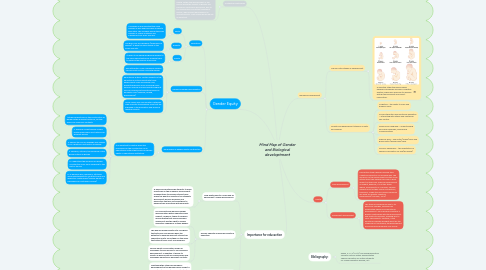
1. Contextual relationship
1.1. The biological development includes the growth of the human being throughout his life, during this growth it is important to maintain a physical, psychological and emotional stability, to have an optimal health. Within the development of the human being the subject of gender has become a continuous discussion, due to the inequalities committed throughout history, which affect development in diverse aspects. That is why gender equity is important.
2. Gender Equity
2.1. Definitions
2.1.1. Parity
2.1.1.1. It focuses on ensuring that the same number of girls and boys have access to education. This includes having the same number of school materials and supplements for boys and girls.
2.1.2. Equality
2.1.2.1. The goal is for all individuals (regardless of gender) to have the same things in the same amounts.
2.1.3. Equity
2.1.3.1. It refers to all individuals gaining access to the same opportunities by allowing them to develop themselves individually.
2.2. Causes of gender discrimination
2.2.1. Role attribution: From childhood children can associate certain roles with gender.
2.2.2. Educational system: Certain aspects of the educational system perpetuate these beliefs about male and female roles, preventing women from accessing some areas of science and discriminating against men for carrying out education based on domestic roles (cooking, nursing, dressmaking).
2.2.3. Social Media and comunication networks: They promote those gender roles that are ingrained in the population and produce negative effects.
2.3. The process of gender equity construction
2.3.1. It is important to identify effective processes for the construction of an educational system that allows for gender equity in educational institutions.
2.3.1.1. 1.Study perspectives on the construction of gender within different historical, cultural and socio-economic contexts.
2.3.1.2. 2. Examine current gender-based relationships which limit options for different groups
2.3.1.3. 3. Explore the role of language and change it for a positive construction of gender
2.3.1.4. 4. Examine, critically, the influence of the global culture on gender
2.3.1.5. 5. Understand the influence of gender construction from early childhood to the rest of the life
2.3.1.6. 6. To develop skills, behaviors, attitudes and understandings to construct equal and respectful relationships (Gender equity: A framework for Australian Schools)
3. Importance for educaction
3.1. How health affects a child and an adolescent´s school performance
3.1.1. A balanced health allows students to work effectively in the academic environment, allowing them to develop intellectually. When the health is affected, the students will present diverse problems and difficulties that will not allow them to develop their education with normality.
3.2. Gender equality and gender equity in education
3.2.1. For long historical periods, gender discrimination within education was evident. However, today it has been demonstrated that every child and adolescent has the right to access education regardless of their gender.
3.2.2. The goal of gender equity is to recognize that both men and women have the potential to develop different intellectual capacities and to focus them on the areas that interest them most as individuals.
3.2.3. Gender equity in education allows all individuals to have access to full academic development. In addition, it brings to society a wide variety of professionals and individuals educated in different contexts.
3.3. Biological importance for education
3.3.1. Identifying the stages of biological development of the human being, allows to understand the cognitive capacities that each stage of development has. Allowing education to be adapted to its possibilities and academic abilities according to the biological context.
4. Health
4.1. Child development
4.1.1. During this stage children develop their cognitive capacity in an amazing way. The influence of the environment and the social interactions they develop will have a great impact on their lives. Physical development is evident, however, it is at this stage where, according to Dr. Almazan, children develop most of their neural connections, therefore, a high stimulus during childhood will allow for greater cognitive development (Almazan, 2015).
4.2. Adolescent development
4.2.1. The stage of adolescence due to its hormonal changes, unleashes an accelerated physical and emotional development. The individual maintains a greater relationship with the environment and relates to his peers, allowing him to form a personality. However, if the emotional changes brought about by the stage are not controlled, the development of psychosocial problems may follow.
5. Biological Development
5.1. The pre-natal stages of development
5.1.1. During this stage the human being develops his senses and basic cognitive abilities, which will allow him to develop with his environment and collect information.
5.2. Growth and development stages in infants and children
5.2.1. Cognition – the ability to learn and problem solve
5.2.2. Social interaction and emotional regulation – interacting with others and mastering self-control
5.2.3. Speech and Language – understanding and using language, reading and communicating
5.2.4. Physical skills – fine motor (finger) skills and gross motor (whole body) skills
5.2.5. Sensory awareness – the registration of sensory information for use(Kid sense)
